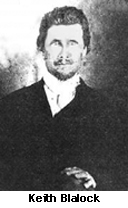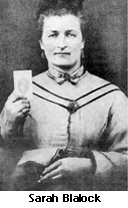|
Against all odds, Sarah Blalock
prevailed throughout Civil War
By Dr. Judy Pierce
Bugle Staff Writer
  If nothing else, Sarah Melinda Pritchard Blalock was unique. If nothing else, Sarah Melinda Pritchard Blalock was unique.
She fought in the Civil War for both the Union and Confederacy. She disguised herself as a soldier for the South and then as a guerilla fighter and raider for the Union.
Sarah was born in 1839 in Caldwell County, N.C., which is now Avery County, near the base of Grandfather Mountain. She was one of nine children and resided in this section of North Carolina until her death in 1903.
While attending a one-room school in Avery County, Sarah met William “Keith” McKesson Blalock, whose family had been rivals with her family for more than 100 years. Although the rivalry between the two families was intense, Sarah and William remained close friends and later sweethearts. Against their families’ wishes, they were married in 1856 when Melinda was 17 at Coffey’s Gap in Watauga County. This added fuel to the rivalry between the families.
After the Civil War began, the people living in the western Appalachian Mountains of North Carolina were very restless and non-trusting of their neighbors. Daily, the neighbors argued aggressively and threatened each other with guns over the Civil War. This was especially true of their kinfolk. Melinda voiced her opinion about the right of secession. On the opposite side, Keith and his stepfather, Austin Coffey, were staunch unionists. Although Keith did not like President Lincoln’s politics, he planned to find a way to join the Union army. The Blalocks’ opposing views did not cause any difficulties in their marriage.
On May 20, 1861, North Carolina adopted an Ordinance of Secession and the Provisional Constitution of the Confederate States of America. These documents required all men between the ages of 18-36 years to join the army. Two recruiters came to the Blalock farm and told Keith he would either enlist in the Confederate army or he would be tried as a traitor.
Keith joined Company F of the 26th North Carolina Infantry commanded by Col. Zebulon Vance. He was allowed to delay his reporting date until November in order to harvest his crops. Keith reluctantly joined the army to keep the mountain people from retaliating against Melinda. During this time, he hatched a plan whereby he could somehow desert the Confederate army and join the Union Army.
While walking down the road in November to Newton to join his unit, Keith noticed a smaller soldier behind him. He stopped to look behind him at the young man and was amazed that the individual was Melinda. She had cut off her long black hair with a hunting knife, put on baggy men’s clothing to hide her gender, and carried Keith’s squirrel gun.
Melinda explained to Keith that her place was with her husband and she was going to fight by his side no matter what. Keith questioned her about her plans. Melinda told him she had joined the same company and regiment that he joined earlier in the year. She said she enlisted as “Sammy Blalock,” Keith’s younger brother.
Keith didn’t know what to think of his wife joining the Confederate army as a man. But once Melinda mentioned the $50 bounty they both received, he wasn’t too upset.
Keith and “Sam’s” plan to defect was not working because six days prior to the Blalocks’ enlistment, the 26th North Carolina Infantry had fought in the Battle of New Bern, and the regiment was recovering near Kinston. Therefore, instead of moving to Virginia’s battlefront, they remained at Kinston.
“Sam” was a good soldier. She gave her age as 20 on the enlistment paper, but was described as a “good looking sixteen-year-old boy weighing about 135 pounds, height five feet, four inches.” For the next month, Sam, tenting and eating with Keith, performed “all of the duties of a soldier.”
They fought in three battles, but during the third engagement, Melinda was wounded in the shoulder by a minie ball. In April 1862, Sam’s squad was ordered to track down a group of people who were aiding the Federal scouts for General Burnside’s advancing army.
While the Confederate patrol was wading across the Neuse River, Keith had a sudden feeling that something was wrong. He stopped the advance and the group headed back to the riverbank. When they almost had reached the riverbank, the Union soldiers across the river opened fire. The Confederate group threw their rifles upon the bank to keep them from getting wet and submerged themselves in the river to avoid the rifle fire until they reached the shore and could run into the cover of the forest. It was found that “Sam” was missing.
Keith came upon a huge pine tree that had fallen from the bank. He began to look for Melinda and found her behind another tree clutching her shoulder. It was bleeding profusely, so he took an old handkerchief and put it into her wound.
He carried Melinda as quickly as he could back to the 26th regiment in his arms and took her to the infirmary tent where a physician discovered her gender when he removed her shirt. The bullet was successfully removed. Keith and Melinda begged the doctor to keep their secret. But, Dr. Boykin agreed to keep their secret for two days only, until Melinda would be back on her feet.
Desperately, Keith decided it was time to act. He ran to a nearby field covered with poison ivy. He stripped his clothes and ran through the underbrush and rolled in the poison ivy.
The next morning when Keith reported to Dr. Boykin, he suffered a persistent fever and his skin was covered with blisters. Keith advised the doctor that he had a recurrent illness. Fearing an outbreak of smallpox, Dr. Boykin discharged Keith quickly from the regiment on April 20, 1862.
Keith was very concerned what would happen to Melinda if he left because her recent wound didn’t merit a discharge. After some discussion with Keith, she decided to tell Col. Zebulon Vance that she was a woman.
Melinda offered herself as a volunteer to “tend” Sgt. Keith on his return home. Colonel Vance’s response was an absolute “no,” declaring that she would be his new personal orderly.
At that point, Melinda revealed the truth about her gender. Vance’s reaction was that of total utter shock. He called Dr. Boykin and commented, “Oh, surgeon, have I a case for you.” Dr. Boykin corroborated Melinda’s statement. And, as quickly as possible, Col. Vance discharged “Sam” and demanded a restitution of “his” original $50 bounty. Melinda repaid the bounty and she and Keith started on their trip home.
Once Keith and Melinda returned to their home on Grandfather Mountain, he was treated for his poison ivy and after a period of time, completely recovered. During his recovery, the State of North Carolina passed the Conscription Act. People living in the area began to see Keith’s good health and questioned why he was not returning to his regiment. Keith said he had performed his duty and had been discharged. The problem was Keith had no discharge in writing.
When Keith was ordered to re-enlist or be considered a traitor, he realized that under the Conscription Act he could be taken by force. Pickets were set up around the Blalock farm to keep him from leaving.
One night, Keith and Melinda gathered food and provisions and waited for the pre-dawn mist to rise from the valley below to cover their escape. They slipped by the militia guarding all routes from their house.
Keith and Melinda joined a group of Unionists also waiting for the mist to clear. The group stayed at the top of the mountain until they were discovered by the militia. As the camp was attacked, Keith was wounded in the arm.
All of the Unionists were captured, but Keith and Melinda were able to escape into eastern Tennessee. The voluntary guerrilla squadrons were on scouting and raiding missions throughout the Appalachian Mountains in North Carolina. They raided Confederate camps and burned bridges across the Watauga River. Keith and Melinda were considered partisans by the Union, but the Confederates considered them bushwhackers.
During the winter months, Keith and Melinda served as guides for the Watauga Underground Railroad. They helped prisoners escape from the Confederate jail at Salisbury, which was the largest facility in the state. Two Union officers visited the camp and invited Keith and Melinda to guide potential recruits out of North Carolina. The regiment of raiders would be designated as the 10th Michigan Cavalry commanded by Col. George Washington Kirk.
Melinda was appointed Kirk’s aide-de-camp and she and Keith happily wore the Union uniform.
Keith’s guerilla force began to torment Watauga County mercilessly. Because of the way they had been harshly treated by southern loyalists, the men raided their farms, stole and murdered. They were soon feared throughout the state.
In retribution, Confederate vigilantes murdered Keith’s stepfather, Austin Coffey, and one of Austin’s four brothers. The other two brothers survived the attack. The Coffeys had been betrayed by some local folks where they were found and killed by Keith after the war.
During the war, some of the most terrifying actions of Melinda and Keith were their two pillaging incursions to the Carroll Moore family farm in Caldwell County. James Moore, one of the sons, was the officer who had recruited them originally. In the first raid, Melinda was injured in the shoulder. During the second raid, Moore’s son was at home, recovering after the Battle of Gettysburg.
Keith was shot in the face and his cheekbone was fractured, destroying his right eye, but he continued to fight, continuing his raids until the end of the Civil War.
After the war, Keith and Melinda lived the rest of their lives with their four children in Avery County. Keith received a three-quarters pension of $175 per month for the loss of his eye.
Sarah died in 1903 in her sleep at the age of 64 and is buried in Montezuma Community Cemetery. Keith moved to Hickory taking his son, Columbus, with him.
On April 11, 1913, Keith died in a railroad accident when he lost control of a handcar on a curve and was crushed to death. Some people attributed his death to a local payback for his past years as a guerilla. He was buried beside Melinda. His stone reads, “Keith Blalock, Soldier, 26th NC Inf., CSA.”
Keith would probably “turn over in his grave” if he knew what his tombstone read.
|



